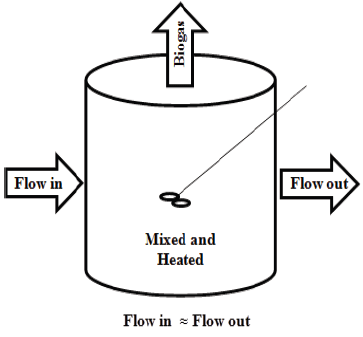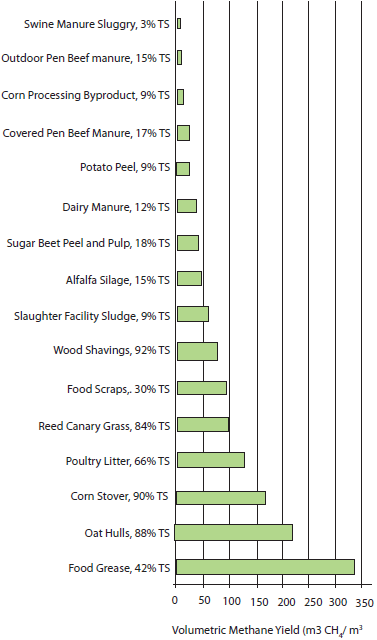



What Every Pork Producer Should Know about Anaerobic Digestion
Pig producers can enjoy all the benefits provided by anaerobic digestion, according to Douglas W. Hamilton of Oklahoma State University in this factsheet for Pig Information Gateway.Introduction
You may have heard it is impossible to digest swine manure. This is not true. Swine farmers can enjoy all the benefits provided by anaerobic digestion. They just have to work a little harder than other livestock producers to get them.
The problem is hog farmers like to handle pig manure as a liquid. The extra water added to manure means digesters on swine farms are larger than those on other farms such as dairies. We can overcome this challenge by using specially designed digesters, scraping rather than flushing manure, or adding a high-energy co-digestion product to the waste stream.
Objectives
This factsheet:
- outlines the benefits of anaerobic digestion
- describes how digesters work
- suggests methods for overcoming the handicaps with swine manure, and
- defines terms used to describe digestion.
Benefits of Digestion
Adding an anaerobic digester to a manure handling system provides a number of benefits. A digester can:
- reduce odors and greenhouse gas emissions (GHG)
- provide on-farm, renewable energy, and
- aid in recycling plant nutrients.
Indirectly, adding a digester may also improve indoor air quality. With a digester to feed, farmers tend to remove manure and clean buildings more frequently.
How Digesters Deliver the Benefits
How does a digester do all these things? Think of a digester as a black box (Figure 1). Raw manure goes into the box. Sludge, biogas, and digested effluent come out of it. The main effect of digestion is converting organic matter to biogas.

Biogas is a mixture of methane (CH4), carbon dioxide (CO2), and a few minor (but not insignificant) gases such as hydrogen (H2), hydrogen sulphide (H2S), and water vapour (H2O). Both methane and carbon dioxide are greenhouse gases. Releasing them into the atmosphere may contribute to global warming. Methane is a much stronger greenhouse gas than carbon dioxide. Methane is also flammable. Burning methane does two things. First, it releases heat energy. Second, when methane burns, it forms carbon dioxide and water vapour. Because the heat trapping ability of carbon dioxide is much lower than methane, burning biogas lowers its greenhouse effect.
We can harness the energy released during combustion by using the heat directly. We can also convert biogas to electricity in an internal combustion engine-generator set or fuel cell. Generator sets and fuel cells also release heat, so they are sometimes called combined heat and power (CHP) systems. The electricity produced can be used on farm or sold to the power company.
Organic matter can be solid or liquid [1]. Manure contains both: solid pieces of undigested food and intestinal bacteria, and soluble organic liquids. A digester reduces soluble organic matter from manure. Soluble organic matter is the main source of odors on hog farms. The digester also converts a large portion (around 50 per cent) of organic solids to biogas.
Sludge is the treated organic matter that settles to the bottom of a digester.
Sludge contains stabilized (less odorous) organic solids, helpful bacteria, organic nitrogen (Org-N), insoluble phosphorus (TP), and micronutrients. All of these are good soil amendments.
The liquid stream, or effluent, flowing from a digester contains soluble nitrogen in the form of ammonium (NH4+), soluble phosphorus (PO4-) and soluble potassium (K+). Effluent contains less organic matter than manure. It also contains salts and micronutrients. Soluble N, P, K and micronutrients are valuable fertiliser. The trick is to use these nutrients while managing salt in the soil.
Digestion is a Living Process
Communities of microorganisms use organic matter as food and release biogas. The two main communities in a digester are the Acid Formers and the Methanogens [2]. Solid organic matter is converted to liquid by acid forming bacteria. Soluble organic molecules are converted to biogas by methanogens.
Digesters Are Reactors that Convert Organic Matter to Biogas
Digesters come in many sizes and arrangements [3]. All digesters are airtight. No oxygen can enter a digester, because oxygen kills methanogens. The reactor is also kept at the proper temperature and pH for the communities to digest organic matter efficiently.
Some Definitions Used to Describe Digesters
The following four definitions help explain how a digester works:
- Hydraulic Retention Time (HRT): the length of time liquid remains in the digester. HRT is usually measured in
days. - Solids Retention Time (SRT): the length of time solid particles stay in the digester. SRT is also measured in
days. - Organic Loading Rate (OLR): the mass of organic matter added to the digester each day, divided by the reactor volume.
- Volumetric Reactor Efficiency (VME): The volume of biogas (or CH4) produced each day, divided by the rector
volume.
A simple, complete mixed digester is shown in Figure 2. Manure flows into a complete mixed reactor, it is mixed and heated, and a roughly equal volume of effluent flows out. Since the complete mixed digester is stirred, there is not a separate sludge stream. Treated solids flow out with effluent.

For a complete mixed digester, HRT is the volume of the reactor divided by the volume of effluent flowing out of the digester. Hydraulic retention time determines digester size. At a given HRT, a farm with a large daily manure volume will have large complete mixed digester; a farm with a small manure flow will have a small digester.
For a complete mixed digester, SRT is the mass of solids contained in the reactor, divided by mass of solids leaving with effluent. Because bacteria settle with sludge, SRT is also the time microbial communities stay in the reactor. A community cannot sustain itself unless its members remain in the digester long enough to reproduce. Methanogens are notoriously slow growers. Communities of methanogens need SRTs greater than 20 to 30 days in order to survive [2].
Volumetric reactor efficiency is important to the farm’s bottom line. Remember, methane is energy. An inefficient digester may not produce enough energy to heat, mix, and pump manure. An inefficient reactor is an expensive treatment component.
Some Definitions Used to Describe Digesters
Two more definitions help explain why some folks do not think swine farms can produce biogas [4]:
- Specific Methane Yield (SMY): The volume of methane produced per mass of organic matter added to a digester.
- Volumetric Methane Yield (VMY): The volume of methane produced per volume of manure added to a digester.
Pound for pound, the organic matter in pig manure produces just as much methane as any other manure. Said another way, the specific methane yield of swine manure is high.
The Problem is the Way We Handle Pig Manure
Manure comes out of hogs wetter than it does from cattle, sheep, horses, and poultry [5]. And since it is easy to move swine manure as a liquid, we add more water to remove it from buildings. Flush tanks, pull-plug pits, and power washers all add water to manure. The extra water means swine manure slurry has low VMY. Figure 4 shows how the VMY of hog manure stacks up against other manures.

Because swine manure contains extra water, swine manure digesters are relatively large for the mass of organic matter added. This means both OLR and VRE are low compared to digesters treating thicker manure.
Overcoming Handicaps to Digestion
All is not lost. Here are a few ways we can make digestion work on hog farms.
Increase the strength of manure. If you have deep pits, use scrapers to remove manure from buildings. If you flush, add a settling tank to thicken manure ahead of the digester. Both of these increase manure solids content and VMY. They also increase maintenance, and you will soon learn why most hog farmers would rather flush than scrape manure.
Go simple and use a covered lagoon to produce and capture biogas. Covering the first cell of a two-stage lagoon [3] will reduce most of the hassles, and gain some of the benefits of digestion. A lagoon needs more space than a mechanical digester, biogas production drops in winter, and much of the fertilizer value remains in the lagoon with sludge. But, if the main energy need is summer ventilation, and the farm is short on land to recycle nutrients, this may be the way to go.
Summary
Anaerobic digesters reduce farmstead odors and minimize the carbon footprint of pork production, while producing on-farm energy. Hog farmers face a large hurdle when it comes to digestion. The low volumetric methane yield of swine manure means, without taking special measures, hog farms have large, inefficient digesters. Pork producers can overcome this hurdle by using reactors specifically designed for dilute manure, thickening manure before it enters the reactor, or adding high energy co-digestion products to the manure stream.
References
[1] Hamilton DW. Organic matter content of wastewater and manure. Stillwater, OK: Oklahoma Cooperative Extension Service; 2012. OSU Factsheet BAE 1760.
[2] Hamilton DW. Anaerobic digestion of animal manure: Understanding the basic processes. Stillwater, OK: Oklahoma Cooperative Extension Service; 2009. OSU Factsheet BAE-1747.
[3] Hamilton DW. Anaerobic digestion of animal manure: Types of digesters. Stillwater, OK: Oklahoma Cooperative Extension Service; 2010. OSU Factsheet BAE-1750.
[4] Hamilton DW. Anaerobic digestion of animal manures: Methane production potential of waste materials. Stillwater, OK: Oklahoma Cooperative Extension Service; 2012. OSU Factsheet BAE 1762.
[5] Hamilton DW. Consistency of manure/water mixtures. Stillwater, OK: Oklahoma Cooperative Extension Service; 2011. OSU Factsheet BAE 1751.
[6] Moody LB, Burns RT, Bishop G, Spajic R. Using biochemical methane potential assays to aid in co-substrate selection for co-digestion. Applied Engineering in Agriculture. 2011; 27(3): 433-439.
July 2013








